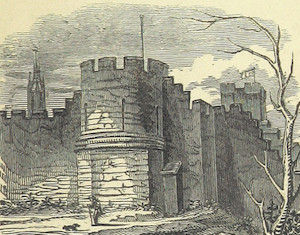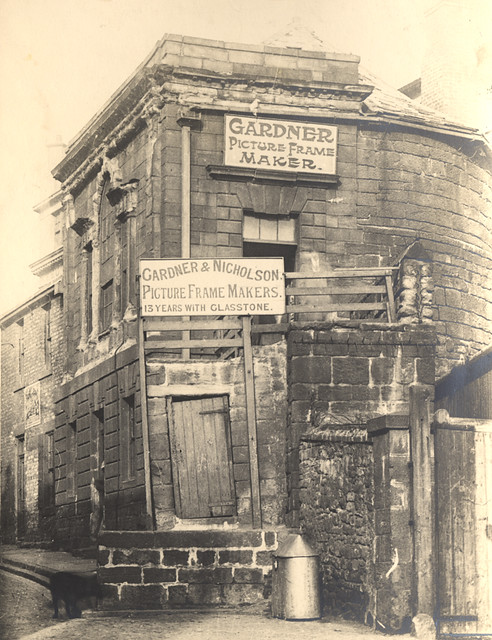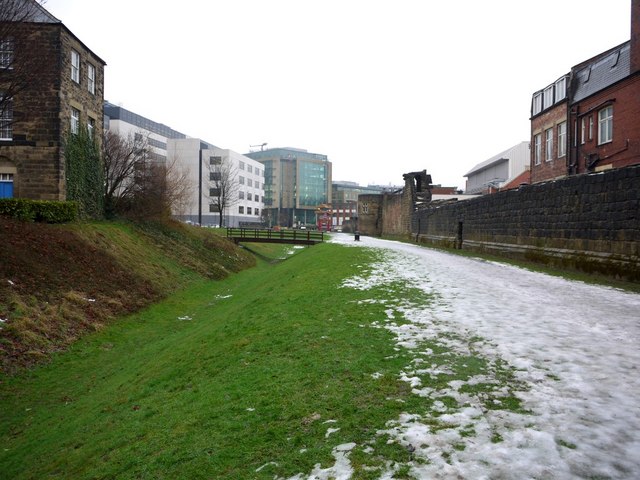Topics > Heritage Sites > Newcastle Town Walls > Town Walls (account by Eneas Mackenzie, 1827)
Town Walls (account by Eneas Mackenzie, 1827)
ACCORDING to Harding in his Chronicle, William Rufus not only built the New Castle upon Tyne, but also fortified the town by walls. It is certain, however, that the town was walled in the reign of king John; for in the charter of the 17th of his reign (1216), the walls are expressly mentioned. Edward I, in 1280 granted the Black Friars a passage to their garden through the new wall, and which port appears to have been finished a year or two afterwards. The same king, in 1299 united Pampedon with Newcastle, which occasioned the building anew of the wall, towards the east, through the close of the Carmelites, or Wall Knoll.
Edward III, in the first year of his reign (1327), granted the custom of things sold at Newcastle upon Tyne for seven years, to contribute towards the reparation of the walls of that town; and in 1334 this king, during his residence there, repaired the walls. The year following Hugh de Merchinleigh, one of the bailiffs of that place, was removed from his office by the commonalty of the town for having procured murage against them.
The mayor and bailiffs of Newcastle upon Tyne having petitioned king Richard II to have the defects in the walls repaired, an assignment was granted them, in the 10th of that reign, to take workmen for their reparation. In 1403, king Henry IV granted to the mayor of Newcastle all fines and forfeitures ,for the reparation of the walls and bridge of that town; and in 1527 mention occurs of an annuity of £20, granted by king Henry VIII for the support of the walls and bridge of Newcastle upon Tyne. During the remarkable siege of that town by the Scots in 1644 the walls were, so much damaged, that parliament granted £2564 for repairing them. In 1667, the common council ordered the walls, gates and draw bridges of the town, to be immediately repaired. The town was again put in a posture of defence during the rebellion in 1745, and several houses and other obstructions near the walls were pulled down. Since that period the utility of such warlike barriers is completely superseded. Great part have been demolished, and many of the fragments that remain are much dilapidated.
These famed walls were twelve feet high, eight feet thick, and strengthened by a wide fosse. The gates in them were all embattled, and the intervening lines commanded by strong towers, "between each of which", says Bourne, "there were for the most part two watch towers made square with effigies of men cut in stone upon the top of them, as though they were watching, and they are called garret, which had square holes over the walls to through stones down."
According to Hutton's plan, the circumference of the walls from the Close gate to Sandgate is 2740 yards By an admeasurement made in 1745, by Mr Thomas Aubone, the whole circuit of the walls, including the space next the river between Sandgate and the Close gate, is 3759 yards 1 foot; or 2 miles, 239 yards and 1 foot. Bourne makes the whole circumference only 2 miles and 176 yards, but does not state his authority.
After the completing of the walls, the town was divided into twenty four wards, according to the number of the gates and towers in them, which were, in times of hostility defended by the particular wards appropriated to them. The wards were,
- Close Gate
- White Friar Tower
- Denton or Nevil Tower
- West Spital Tower
- Stank Tower
- Gunner Tower
- Pink Tower
- West Gate
- Durham Tower
- Herber Tower
- Morden Tower
- Ever Tower
- Andrew Tower
- New Gate
- Bartram Monbowcher Tower
- Ficket Tower
- Pilgrim street Gate
- Carlell Tower
- Plummer Tower
- Austin Tower
- Corner Tower
- Pandon Gate
- Wallknoll Tower
- Habkyn Tower
The Close Gate evidently derived its name from the street called the Close. After the fall of the Tyne Bridge in 1771, its tower was converted into a temporary prison. In 1797, it was taken down; the gateway being narrow, awkward, and dangerous. There was a turret, or tower, 52 yards to the south of this gate, and adjoining to the river. It was once the meeting house of the House Carpenters' Company, and afterwards of the Sailmakers. From the Close Gate, there were an hundred and forty steps, on the top of the wall, as it mounts a very steep hill to White Friar Tower.
White Friar Tower was so called from the adjoining house of the Carmelites, or White Friars. A breach was made in the wall here, and a mine sprung, when the town was stormed by the Scots. The fraternity of Masons had their hall in the upper apartment of the tower. In the lower one was the meeting house of the Bricklayers and Metters. In 1776, Isaac Cookson, Esq obtained a lease of this tower, which he converted into an ice house. It is still in the possession of this gentleman.
Denton or Nevil Tower is supposed to derive the first of these appellations from John de Denton, who was a bailiff of Newcastle in 1339, or from some of his family; as it undoubtedly does the second from the Nevil family, whose town house called Westmoreland Place, stood near, and is said to have communicated with it by a subterraneous passage. Bourne supposes that the postern below the tower was made for the convenience of the White Friars, that they might walk to the Forth and neigh bouring fields. He also imagines this to have been the gate through which, in the reign of Edward III, three hundred valiant men sallied by night, and rushing into the camp of the Scots, routed the whole army, and took the Earl of Murray prisoner in his tent. This postern was remarkably strong, having gates of oak, iron doors and a heavy portcullis. The arms of Clavering and Shaftoe were cut in stone over the gateway; and these names occur as mayor and sheriff in 1607, 1629, and 1663. The tower is at present the hall of the company of Wallers Bricklayers and Plaisterers; but the gate was pulled down in 1805. The old wall from the White Friar Tower to this place, though mostly hid by buildings is in a good state of preservation.
West Spital Tower derived its name from St Mary's hospital, otherwise called "West Spital", which stands very near it, and was probably built by the master and brethren of that establishment for their security and defence. It is certain that they obtained a patent in 1290, for making hereabouts a postern gate in the town wall. This now forms part of a genteel dwelling house, and its circular walls may still be seen in a good state of preservation.
Stank Tower - The upper part of this tower is demolished. There is a passage through it to a dwelling house, and another into a garden. The adjoining walls are greatly dilapidated.
Gunner Tower or rather Gunnerton Toiver, is said to have been built by the ancient family of Swinburn, who had a house behind it. In 1821, it was converted into a hall for the incorporated company of Slaters and Tylers; on which occasion the workmen found a large quantity of shillings and sixpences, of the coinage of Edward I. The tower has been very neatly repaired, and the hall is light and spacious. Between this tower and the next, a postern conducting to the Forth was made in 1705, as appeared by an inscription over the gate way. When it was made, a Mr Whitfield gave to the public, out of his private property, the lane which leads to it from Westgate Street. This gateway was taken down in 1811; and the whole wall between it and Gunnerton Tower has lately been removed.
Pink Tower - The basement story of this tower is still in a state of good repair. It is used for the convenience of the adjoining inhabitants.
THE West Gate consisted of four wards, and was secured by massive gates of oak and iron doors. Leland calls it "a mightye strong thinge". It was once a prison for unruly apprentices; and during the civil war; contained seventeen prisoners who clandestinely obtained ropes, and, during a violent stormy night, let themselves down by the privy and escaped. After this it became the hall of the incorporated company of House Carpenters. A foot-way was opened out on the north side of this gloomy gateway in 1782; but, in 1811, the whole was pulled down, and also part of the wall on the south side. According to tradition, this strong gate was built by the wealthy and munificent Roger de Thornton.
Extract from:
Eneas Mackenzie. A Descriptive and Historical Account of the Town & County of Newcastle-upon-Tyne, Including the Borough of Gateshead. Mackenzie and Dent, 1827.
Digitised Google eBook

from https://books.google.co.uk/bo…
A Descriptive and Historical Account of the Town and County of Newcastle Upon Tyne: Including the Borough of Gateshead. Eneas Mackenzie, 1827.
- Digitised Google eBook.
Added by
Simon Cotterill

Co-Curate Page
Siege of Newcastle, 1644
- Overview About The Siege of Newcastle 3rd February1644: start of the Siege of Newcastle, which lasted until 19th October 1644, when the Scottish Covenanters took the city. The Siege of …

Co-Curate Page
Newcastle Town Walls
- Overview About the Town Walls The defensive Town Wall at Newcastle was built in the 13th and 14th centuries at a time when the North of England was under frequent …

from Newcastle libraries (flickr)
003794:Plummer Tower Newcastle upon Tyne Unknown 1915?
Pinned by Simon Cotterill

from http://www.british-history.ac…
Town walls and gates
- Detailed referenced history of the Town Walls in Eneas Mackenzie's 1827 book.
'Fortifications and buildings: Town walls and gates', Historical Account of Newcastle-upon-Tyne: Including the Borough of Gateshead (1827), pp. …
Added by
Simon Cotterill

Co-Curate Page
The fosse (defensive ditch)
- The fosse was a defensive ditch around the Town Walls of Newcastle; sometimes referred to as 'the King's Dykes'. Little remains of the fosse today, except by the west wall. …


from https://books.google.co.uk/bo…
A Descriptive and Historical Account of the Town and County of Newcastle Upon Tyne: Including the Borough of Gateshead. Eneas Mackenzie, 1827.
- Digitised Google eBook.
Added by
Simon Cotterill

Co-Curate Page
Siege of Newcastle, 1644
- Overview About The Siege of Newcastle 3rd February1644: start of the Siege of Newcastle, which lasted until 19th October 1644, when the Scottish Covenanters took the city. The Siege of …

Co-Curate Page
Newcastle Town Walls
- Overview About the Town Walls The defensive Town Wall at Newcastle was built in the 13th and 14th centuries at a time when the North of England was under frequent …

from Newcastle libraries (flickr)
003794:Plummer Tower Newcastle upon Tyne Unknown 1915?
Pinned by Simon Cotterill

from http://www.british-history.ac…
Town walls and gates
- Detailed referenced history of the Town Walls in Eneas Mackenzie's 1827 book.
'Fortifications and buildings: Town walls and gates', Historical Account of Newcastle-upon-Tyne: Including the Borough of Gateshead (1827), pp. …
Added by
Simon Cotterill







